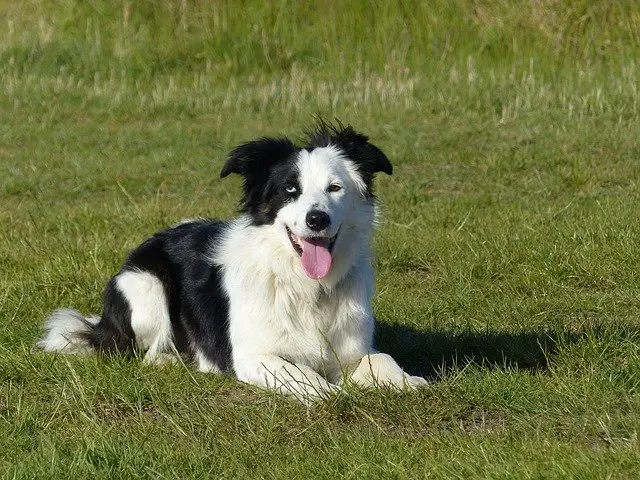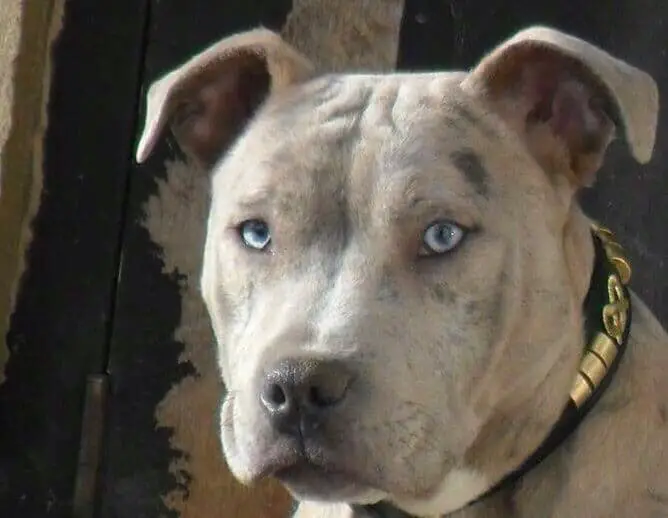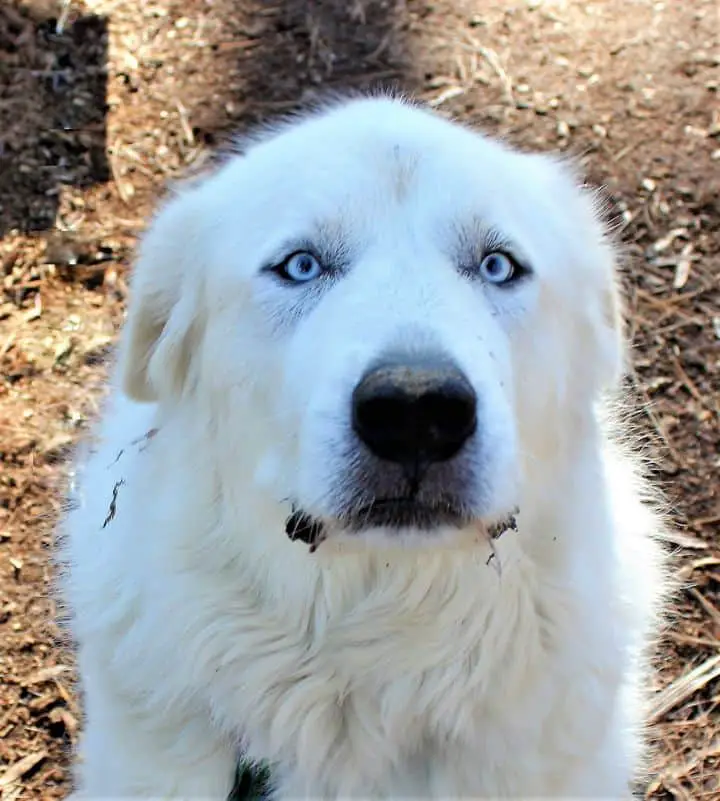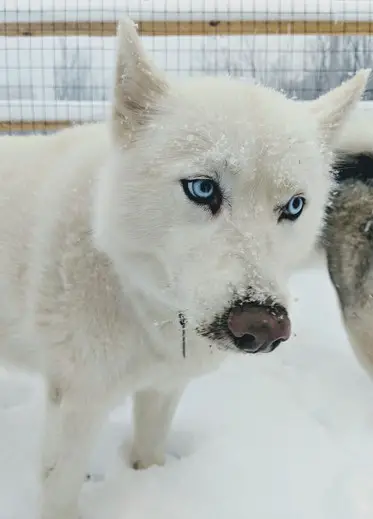Anyone who is a dog lover is familiar with those deep brown dog eyes that make you feel loved. For some dog owners, especially new ones, you may be surprised to learn that there are some dogs that have blue eyes and even some that have just one blue eye.
Why are dogs born with blue eyes? Blue eyes in dogs are caused by genetic factors. The M-locus gene and the S-locus gene are known to predict high probability of blue eyes. Additionally, duplication of the ALX4 gene can also impact eye color. These three genetic factors explain roughly 75% of blue eyed dogs, while the remaining 25% is still unknown.
I admit that I have never really gave dogs with blue eyes a ton of thought. It wasn
There is a lot to know about dog’s with blue eyes. Most dog’s have the traditional brown eyes and those piercing blue eyes are very rare. It’s important to know that dog’s that posses the genetic potential to have blue eyes can have two blue eyes, or two eyes of different color, known as heterochromia.
In this article we will cover the following topics:
- What causes blue eyes in dogs?
- Breeds that commonly have blue eyes
- Other breeds that can sometimes have blue eyes
- Blue eyes and Albinism
- Frequently Asked Questions about dogs with blue eyes
What causes blue eyes in dogs?
Dogs having blue eyes, just like humans, is due to genetic factors influencing eye color.
Just as with humans, blue eyes in dogs are caused by lack of color in the eyes. The eyes appear to be blue based on how the light reflects from the eye. This is similar to why sky looks blue, but really isn’t. The sky only looks blue because of the reflection of light. Yep – it’s crazy, but totally true. Its called the Tyndall effect!
There are two genes that predict when a dog is more likely to have blue eyes. The first is the gene that influences the merle coat (known as the M-locus gene). The second is the gene that influences the piebald coat (known as the S-locus gene). Dogs with these pattern coats also have a higher likely hood of blue eyes.
However, those two genes only offer a partial explanation. Those genes don’t explain why dog’s without those pattern coats can have blue eyes. For instance, Siberian Huskies and Tri-colored Australian Shepherds can have blue eyes, but neither have the M-locus or S-locus genes.
However, a recent study by dog DNA company Embark, took a look at eye color by comparing genetic variation with trait variation. The study was able to provide additional answers as to why dogs without the M-locus and S-locus gene can still have blue eyes.
Long story short, the study discovered the “genetic sequence near the ALX4 gene contains some duplication that disrupts the formation of pigmentation in the eyes.” Embark further explains that the M-locus and S-locus genes, as well as, the found duplication near the ALX4 gene explains about 75% of the blue eyed dogs in Embark’s database.
LINKS: If you want to nerd out on the study, you can follow the links to the Embark study HERE, as well as, Embark’s summary on their blog HERE.
Breeds that commonly have blue eyes:
Australian Shepherd

Australian Shepherds commonly have one or two blue eyes. Aussies can also have any eye color combination of brown, blue, hazel, amber or green. American Indians held Aussies in high regard and referred to them as “Ghost Eye” due to their blue eyed trait.
Siberian Husky

Huskies are another well known breed to commonly have one or two blue eyes. These piercing blue eyes add beautiful mystique to their already gorgeous coats. Huskies blue eyes are attributed to the mutation of the ALX4 gene mentioned above.
Catahoula Leopard Dogs

Cathoula Leopard dogs often have one or two blue eyes. This is due to the genes associated with the Merle color coats.
Corgi

Corgis can have one or two blue eyes if they have a merle coat. The official breed standard accepts one or two blue eyes only if the dog has specifically a blue merle coat.
Border Collie

Border Collies are another breed that can have often have blue eyes due to the merle gene. Border Collies more commonly have brown eyes, but this one or two blue eye trait does occur. Two different colored eyes were once a desired trait as shepherds believed one eye could control better up close and the other from far away.
Shetland Sheepdog

Shetland Sheepdogs, or Shelties, like most of the dogs on this list, can have blue eyes due to their merle gene. Merle Shelties will frequently have only one blue eye, while the other will be brown or amber.
Other Breeds that can sometimes have blue eyes
Technically speaking, any dog can be born with blue eyes. This is due to many years of cross breeding different lines and recessive genes. However there are some breeds that it occurs often, but not what we would call commonly:
American Pit Bull Terriers

American Pit Bulls can occasionally have blue eyes, typically occurring in blue coat and noses, as well as, merle patterns.
American Staffordshire Terriers

American Staffordshire Terriers, or just Staffys, are most often born with brown, amber, hazel, or green eyes, but have been know to also produce some blue eyed dogs as well.
Australian Cattle Dogs

Blue eyes show up in these breed now and again. This is mainly due to the cross breeding in the origin of the Australian Cattle Dog.
Boxers

Blue eyes have occurred in boxers sporting brindle, fawn, and white coats due to a recessive gene.
Cocker Spaniels

While not super common, Cocker Spaniels bearing a merle coat can have blue eyes. Currently the American Kennel Club (AKC) does not currently recognize merle coats or blue eyes in Cocker Spaniels.
Dalmatians

Dalmations with blue eyes can be somewhat common due to lack of melanin producing cells. This is also what can cause common blindness and hearing loss in this breed.
Great Danes

Great Danes with a merle or harlequin pattern can have blue eyes. The AKC allows for blue eyes in Great Dane with those coat patterns.
Great Pyrenees

While blue eyes are not an accepted breed standard, Great Pyrenees are occasionally born with blue eyes. Having blue eyes takes this already majestic looking breed over the top.
Old English Sheepdogs

Old English Sheepdogs can occasionally have blue eyes. In fact, the AKC does not fault Old English Sheepdogs having one or two blue eyes.
Weimeriners

Weimeriners can technically have blue eyes, but it is more of a bluish-grey then a true ice blue or deep blue.
Blue Eyes and Albinism
There are some people that incorrectly assume that blue eyes in dogs is the result of Albinism. However, having blue eyes is not the same thing as having Albinism.
Albinism is the lack the genes that produce melanin – the pigment responsible for skin, eye, and hair color. Therefore an animal that is albino, lacks melanin all over, not just in a certain part of their body.
Frequently asked questions about blue-eyed dogs
Through further researching the topic of blue eyes, there were several popular questions that kept coming up:
Are dogs with blue eyes unhealthy?
Most dogs born with blue eyes are perfectly healthy. However, dogs born from two merle pattern parents have a higher chance of health issues. Sudden development of bluish eyes in an adult can be signs of some serious health concerns.
Born with Blue Eyes
Being born with blue eyes is typically only an issue if two merle dogs are bred with one and other – referred to as a “double-merle”. A double-merle has a much higher chance of being born with, or developing, blindness or deafness, as well as other dangerous health issues.
Later Development of Blue eyes
If your dog’s eyes suddenly turn blue or cloudy, this is a strong sign of Cataracts or Glaucoma, as well as other health concerns. If you observe this happening, have your dog seen by your veterinarian as soon as possible, as some conditions can cause permanent blindness in your pooch.
Common causes of an older dog developing a bluish color in one or both eyes (click on links for more information from PetMD) :
- Cataracts
- Glaucoma
- Lenticular sclerosis
- Corneal dystophy
- Anterior uveitis
- Adenovirus 1 (Canine Hepatitis)
Are dogs with blue eyes blind?
Dogs born with the trait of blue eyes are usually perfectly fine and does not point to any reason for concern. If your dog is a “double-merle” (born from two merle parents) there is high chance of them developing blindness. Breeding two merle dogs is considered irresponsible.
As mentioned above, if you dog’s eye color suddenly changes, you should have your dog seen by your veterinarian to ensure nothing serious is going on. Sudden onset of blue or cloudy eyes can be Cataracts or Glaucoma. Left untreated, some of these conditions can cause permanent blindness to your dog.
Are dogs with blue eyes rare?
Dogs with blue eyes are rare when you compare this trait across all dogs as most have brown eyes. However, within certain breeds, such as Siberian Huskies or Australian Shepherds, this trait is actually quite common.
Are dogs with blue eyes colorblind?
There is no evidence to suggest that blue eyed dogs have any different color vision than dogs with brown or amber colored eyes. In fact, all dogs have vision that is similar to humans with red-green colorblindness. That’s right, dogs do not see in black and white.
For more information on this, check out our other article on a dog’s senses by clicking HERE.
Are dogs with blue eyes deaf?
No, most dogs with blue eyes are perfectly fine and are not more prone to deafness than any other dog. The only exception being if two merle dogs are bred with one and other – referred to as a “double-merle”. A double-merle has a much higher chance of being born deaf or developing deafness.
Are dogs with blue eyes more aggressive?
There is no evidence to suggest that dogs with blue eyes have any more or less possibility of be aggressive. This misconception may be do to the fact that these dogs can look intimidating when starring because of their piercing blue eyes.
Conclusion
So now, we know what makes dogs have those icy blue eyes. These dogs are quite beautiful and it is especially cool that blue eyes are rare across all dogs as a whole.
It will be interesting to see, as genetic science improves, if studies will be able to provide insight and answers to the current unknown reasons for those blue peepers.
Whether just one, or two blue eyes, the stare from one of these dogs is memorizing. There is something about those piercing blue eyes that makes you feel as though the dog has one foot in another world. It’s easy to see why the American Indians held such high regard for Australian Shepherds with this trait.


